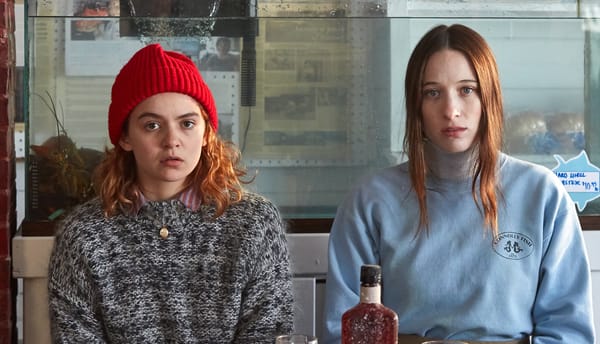Netflix and Spill
The biggest streaming service just took a tumble -- should you still subscribe? And which services really deserve your money?

Is it time to leave Netflix?
It shouldn’t be this hard to break up with a streaming service. Because it was one of the first on the block and because it has been so ambitious in its programming, Netflix has become a generic trademark, like Kleenex and ChapStick and Band-Aids. Every time I publish a list of recommended movies available on demand, people want to know why there are so few Netflix offerings, because it’s the one service everyone has.
But the tide seems to be shifting. Last week, the streaming giant announced that it had lost 200,000 subscribers since the beginning of 2022 and is on track to lose 2 million by midyear. The next day, Netflix stock dropped through the floor, losing 35 percent of its value in a Wall Street fire sale. With 221 million subscribers, the service is still king of the streaming jungle, but for the first time it seems vulnerable. Disney+ passed the 100 million subscriber mark in March of 2021 – achieving in 16 months what took Netflix a decade – and analysts expect it to surpass Netflix by 2024. And it isn’t just Disney (at 130 million by end of 2021) biting off a chunk of the business, but also Amazon Prime (200 million subscribers), HBO/HBO Max (74 million), Paramount+/Showtime (56 million), Apple TV+ (which doesn’t release subscriber numbers), and many others. The fact that a lot of those channels have exclusive libraries of movies and shows while Netflix has spent like crazy trying to build its own content over the past decade is another factor in the competition’s favor.
So why are you still subscribing to Netflix? And which services do you actually need?

It depends, of course, on what you like to watch. If you’re into catching up on back seasons of popular TV shows like “Breaking Bad” or “Seinfeld” and watching series from England (“Peaky Blinders”) and other countries (“Squid Game,” “Money Heist”), Netflix is still a good deal. It’s solid on the stand-up comedy front (Hannah Gadsby, Dave Chappelle, Eric Andre, et al.) For movies there are three types of “Netflix originals”: low-budget romantic comedies aimed at audiences in their teens and 20s, Hollywood stars slumming it in subpar comedies (“The Bubble,” “Red Notice”), and Oscar bait either co-produced in house or picked up at festivals. The non-original film fare is mostly junk and shoddily curated; if you love movies and only movies, you shouldn’t bother with Netflix except during awards season.
Ah, but those original Netflix series. Do you really want to miss “Russian Doll,” “Bridgerton,” “Stranger Things,” “Sex Education,” or “The Queen’s Gambit”? In fact, many of the streaming services have invested heavily in original series, because they get a lot of ink and attract new subscribers. That’s great for the film production industry but a mixed blessing for viewers, because keeping up with all those critically acclaimed Netflix shows plus “Fleabag” and “The Marvelous Mrs. Maisel” (Amazon Prime) plus “Succession” and “Julia” (HBO Max) plus “Ted Lasso” and “Severance” (Apple TV+) plus “Outlander” (Starz) plus “Atlanta” (FX) is exhausting to the wallet and to the brain.
Last week’s Netflix stumble is the first tremor in what will be a coming VOD shakeout, and I have no idea who’s going to come out on top aside from Disney. One of the initial changes you’ll see is a crackdown on shared passwords: Netflix plans to tack on an extra fee for any accounts where usage is coming from outside the home address, and the other streamers will be watching closely. Netflix will also most likely be adding a cheaper subscription tier with advertisements, following the lead of services like Hulu and HBO Max. We will likely see more mergers like the recent union of The Discovery Channel with WarnerMedia (home of HBO) or Disney’s 2019 gobbling up of Twentieth Century Fox. It may be that we’ll end up with three content streamers just like in the old days of ABC, CBS, and NBC, which will be a relief to all of us who can’t even remember which services we currently subscribe to. New technology always fragments the business landscape before the inevitable consolidation of “winners.”

Where does that leave you as a viewer? First, figure out which original series you want to watch and discontinue the service when you’re done watching it. It sounds like a headache but it’s not if you keep a list; most streamers make it surprisingly easy to go online and switch a subscription off or back on. It may mean you’re always on the hook for HBO Max or Netflix or that you sign up for Showtime just to watch “Billions” or “The Good Lord Bird” and then binge and bail. I do this most with Hulu (watched “Reservation Dogs” and moved on), Starz (re-upped for the new season of “Outlander”), FX (“Atlanta” and “Better Things” and that’s all), and a handful of others.
If you have kids, you’re probably going to be subscribing to Disney+ ($7.99/mo or$79.99/year); if not, not. Hulu has an excellent library of TV series, a well-chosen roster of exclusively streaming movies, and some very good originals (“Killing Eve,” “Only Murders in the Building”); you can get it as a standalone service ($6.99/mo with ads, $12.99/mo without) or bundled with Disney+ and/or ESPN+ and/or live TV. If you have an Amazon Prime membership for free shipping, you already have Prime Video; if you don’t, you can still choose from a vast trove of streaming movies and shows on regular Amazon for the price of a cheap rental – the back catalog of classic movies is endless. It’s the same business model and the same trove available on the Apple TV app, which is free; paying for an Apple TV+ subscription ($4.99/mo) only adds the original movies and shows, which are a mixed enough bag to warrant the toggle approach outlined above.
If you have an AT&T cellphone account, you’re already getting HBO Max for free; otherwise it’s $9.99/mo for the ad-supported version and $14.99/mo for ad-free. That service has a deep enough bench of movies through its Warner Bros. libraries and selected Criterion Channel content that you can stream a great many movies that you’d otherwise have to rent on Amazon. Of course, if you’re a hardcore movie hound, the Criterion Channel is the place to be – it’s pricey at $10.99 a month or $99.99 a year, but that’s still cheaper than Netflix’s standard ($15.49/month) or premium ($19.99/month) plans or Amazon Prime ($119/year and set to go up to $139) and the film curation is the best in the business. MUBI ($10.99/mo) and Film Movement ($5.99/mo or $59.99/year) offer even more rarified indie and international pleasures, and there are streaming niche services for just about every taste, from horror (Shudder, $5.99/mo) to Hallmark (Hallmark Movies Now, $4.99/mo). Classic movie aficionados can stream oldies on the Watch Turner website but only if they have a cable subscription to the Turner Classic Movie channel; TCM isn’t available as a standalone service on a Roku or other TV add-on device.

If you have a library card, you can also access services like Kanopy and Hoopla, which have sophisticated offerings of new movies, classics, Criterion releases, and TV shows, but while those services are free to the viewer, the libraries get charged a hefty enough fee that most limit how many times you can stream per month. In 2019, the New York City library system discontinued Kanopy entirely, citing unsustainable costs.
Does all this answer the question of whether you actually need Netflix? Not really. But for the first time in years it’s a question you should be asking.
If you enjoyed this edition of Ty Burr’s Watch List, please feel free to share it with friends.
If you’re not a paying subscriber and would like to sign up for additional postings and to join the discussions, here’s how:
If you’re already a paying subscriber, I thank you for your generous support.





